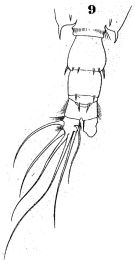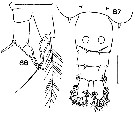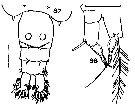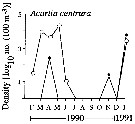|
|
 |
|
Calanoida ( Order ) |
|
|
|
Diaptomoidea ( Superfamily ) |
|
|
|
Acartiidae ( Family ) |
|
|
|
Acartia ( Genus ) |
|
|
|
Odontacartia ( Sub-Genus ) |
|
|
| |
Acartia (Odontacartia) centrura Giesbrecht, 1889 (F,M) | |
| | | | | | | Syn.: | no Acartia centrura : Tranter & Abraham, 1971 (p.223, fig.M). | | | | Ref.: | | | Giesbrecht, 1892 (p.508, 523, 770, figs.F,M); Giesbrecht & Schmeil, 1898 (p.155); Wolfenden, 1911 (p.357); Sewell, 1914 a (p.240); Steuer, 1923 (p.27, figs.F,M); Sewell, 1924 (p.790); 1932 (p.396); Wellershaus, 1969 (p.273, figs.F); Goswami & Goswami, 1973 (p.242, fig.1, karyotype); Berdugo, 1974 (p.85, Rem.); Abraham, 1976 (p.73, 79, figs.F,M); Bradford-Grieve & al., 1999 (p.886, 962, figs.F,M); Srinui & al., 2019, p.90, Rem. F, M); Lee S. & al., 2019 (p.86, Table 3). |  issued from : W. Giesbrecht in Fauna Flora Golf. Neapel, 1892, 19. [Taf.43, Fig.9]. Male: 9, thoracic segment 5 and urosome (dorsal).
|
 issued from : W. Giesbrecht in Fauna Flora Golf. Neapel, 1892, 19. [Taf.30, Fig.31]. Male: 31, P5.
|
 issued from : W. Giesbrecht in Fauna Flora Golf. Neapel, 1892, 19. [Taf.30, Fig.26]. Female: 26, P5.
|
 Issued from : S. Wellershaus in Veröff. Inst. Meeresforsch. Bremerh., 1969, 11 (2). [p.274, Fig.86-87]. Female (from Cochin Backwater, S. India): 86, P5 (terminal spines seen in two different aspects); 87, last thoracic segment and urosome (dorsal). Nota: The specimens tend to reduce or loose spines on the urosoal segments 1-3. In some females segment 9 of A1 bears one ot two small spinules near the distal margin on the posterior side.
Scale : single line = 0.1 mm ; double line = 0.05 mm.
|
 issued from : S. Abraham in Crustaceana, 1976, 30 (1). [p.75, Figs.4-6]. Female (from Cochin, India): 4, urosome (dorsal); 5, P5; 6, right A1.
|
 issued from : S. Abraham in Crustaceana, 1976, 30 (1). [p.76, Figs.13-16]. Female: 16, Md (masticatory edge). Male (from eastern Mediterranean): 13, posterior part of last thoracic segment and urosome (dorsal); 14, P5 (posterior view); 15, right A1.
|
 issued from : S. Abraham in Crustaceana, 1976, 30 (1). [p.79, Table I]. Comparative list of characters female of A. bowmani and A. centrura.
|
 issued from : S. Abraham in Crustaceana, 1976, 30 (1). [p.79, Table II]. Comparative list of characters male of A. bowmani and A. centrura.
|
 Issued from : S. Wellershaus in Veröf. Inst. Meeresf. Bremerhaven, 1969, XI. [p. 274, Fig. 86-87]. Female (from Cochin Backwater and outlet, W Thevara): 86, P5; 87, urosome (dorsal). Nota: - Ratio prosome : urosome 3.8 yo 4.1. - Proportions of the abdominal segments plus caudal rami: 43 : 23 : 6 : 25 = 100.
|
 Remark: Erratum concerning the name: read Srinui and not Siruani. Female: 1 - Genital double-somite having paired posterodorsal processes. 2 - 2nd segment of A1 without strong curved processes. 3 - Exopod of P5 thickened proximally, extending midway along exopod. Male: 1 - Urosomite 3 with large spine-like processes dorsally. 2 - Dorsal processes of urosomite 3 short, reaching posterior-most border of urosomite 4. 3 - Urosomites 3 and 4 each with 2 prominences between pair of dorsal processes.
|
 Issued from : S. Lee, H.Y. Soh & W. Lee in ZooKeys, 2019, 893. [p.84, Table 3]. Acartia (Odontacartia) centrura: Morphological characters. Compare with other Odontacartia species. Nota: 1 - Absence of spine on 1st to 2nd segments of female A1 .....2. 2 - Spine present on dorsal surface of female genital double-somite ..... 3. 3 - Dorsal surface of female genital bouble-somite and 2nd urosomite with 2 strong spines .....4. 4 - Female P5 outer seta longer than terminal spine ..... 5. 5 - Length-width ratio of female caudal rami as 1.7; medial process on 2nd exopodite male left P5 as spine.
| | | | | Compl. Ref.: | | | Thompson & Scott, 1903 (p.236, 254); Gurney, 1927 (p.155, Rem.); Sewell, 1948 (p.324, 431, 461); Delalo, 1968 (p.138); Patel, 1975 (p.660); Moraitou-Apostolopoulou, 1985 (p.303, occurrence/abundance in E Mediterranean Sea, Rem.: p.313); Madhupratap & Haridas, 1986 (p.105, tab.2); Ramaiah & Nair, 1997 (tab.1); Nair & Ramaiah, 1998 (p.272, fig.4); Achuthankutty & al., 1998 (p.1, Table 2, fig.5, seasonal abundance vs monsoon); Mauchline, 1998 (tab.78); El-Sherif & Aboul Ezz, 2000 (p.61, Table 3: occurrence); Dalal & Goswami, 2001 (p.23, tab.2); Belmonte & Potenza, 2001 (p.173); El-Serehy & al., 2001 (p.116, Table 1: abundance vs transect in Suez Canal); Obuid Allah & al., 2005 (p.123, occurrence % vs metal conbtamination); Madhu & al., 2007 (p.54, Table 4, abundance vs monsoon); Rakhesh & al., 2008 (p.154, abundance vs stations); Cornils & al., 2010 (p.2076, Table 3); Zenetos & al., 2010 (p.397); El-Serehy & al., 2013 (p.2099, Rem.: p.2101); Varadharajan & Soundarapandian, 2013 (p.2: occurrence vs stations); Rakhesh & al., 2013 (p.7, Table 1, abundance vs stations); | | | | NZ: | 4 + 2 doubtful | | |
|
Distribution map of Acartia (Odontacartia) centrura by geographical zones
|
| | | | | | | | |  Chart of 1996 Chart of 1996 | |
 issued from : C.T. Achuthankutty, N. Ramaiah & G. Padmavati in Pelagic biogeography ICoPB II. Proc. 2nd Intern. Conf. Final report of SCOR/IOC working group 93, 9-14 July 1995. Workshop Report No. 142, Unesco, 1998. [p.8, Fig.6]. issued from : C.T. Achuthankutty, N. Ramaiah & G. Padmavati in Pelagic biogeography ICoPB II. Proc. 2nd Intern. Conf. Final report of SCOR/IOC working group 93, 9-14 July 1995. Workshop Report No. 142, Unesco, 1998. [p.8, Fig.6].
Salinity ranges for A. centrura in coastal and estuarine waters of Goa (India).
Shaded area indicates the range of higher abundance. |
 issued from : C.T. Achuthankutty, N. Ramaiah & G. Padmavati in Pelagic biogeography ICoPB II. Proc. 2nd Intern. Conf. Final report of SCOR/IOC working group 93, 9-14 July 1995. Workshop Report No. 142, Unesco, 1998. [p.6, Fig.5]. issued from : C.T. Achuthankutty, N. Ramaiah & G. Padmavati in Pelagic biogeography ICoPB II. Proc. 2nd Intern. Conf. Final report of SCOR/IOC working group 93, 9-14 July 1995. Workshop Report No. 142, Unesco, 1998. [p.6, Fig.5].
Monthly occurrence of Acartia centrura in coastal (black circle) in front of Goa and and the Mandovi estuary (clear circle). |
 issued from : C.T. Achuthankutty, N. Ramaiah & G. Padmavati in Pelagic biogeography ICoPB II. Proc. 2nd Intern. Conf. Final report of SCOR/IOC working group 93, 9-14 July 1995. Workshop Report No. 142, Unesco, 1998. [p.3, Fig.2]. issued from : C.T. Achuthankutty, N. Ramaiah & G. Padmavati in Pelagic biogeography ICoPB II. Proc. 2nd Intern. Conf. Final report of SCOR/IOC working group 93, 9-14 July 1995. Workshop Report No. 142, Unesco, 1998. [p.3, Fig.2].
Hydrography of the coastal station in front of Goa and Mandovi estuarine station (W India).
Nota: The seasons are arbitrarily classified into the southwest monsoon (June-September), postmonsoon (October-January) and premonsoon (February-May). |
| | | | Loc: | | | Atlant. (off N Ste Helene), E Medit (Israel coast), Suez Canal (Suez Bay, Port Taufik, Bitter Lakes: very common, Ismaïlia, Lake Timsah, El Guiar, El Kantara, El Tineh, Ras-el-Ech, not Port Said after Gurney, 1927), , Safâga, Red Sea, Oman Sea, Bombay, Mandovi-Zuari estuary, Kerala, Goa, Sri Lanka, India (NW, Saurashtra coast, Godavari estuary, Kinada Bay, Chilka Lake, Poiintcalimere, Manamelkudi, ), Burma, Indonesia (SW Celebes). | | | | N: | 26 (Atlant.: ?1; Medit.: 1; Suez Canal: 4; Red Sea: 4; N Indian: 16, Indonesia: 1) | | | | Lg.: | | | (46) F: 1,24-1,2; M: 1,03; (80) F: 1,13; M: 1,028; (172) F: 1,3-1,2; (919) F: 1,35; M: 1,25; {F: 1,13-1,30; M: 1,03} | | | | Rem.: | ± brackish (Salinity:10 to31 p.1000), estuary-neritic.
The dimensions seem to be correlated with the salinity.
Report of this form off SW Ireland by I.C. Thompson (1903 a, p. 31) needs to be confirmed, as well as the form reported by Dakin & Colefax (1933, p.207) in Australia (New South-Wales).
Possible introduction in the Mediterranean from the Red Sea.
After Wellershaus (1969, p.273) the animals tend to reduce or loose spines on the abdominal segment 1 of the female: the spines cannot always be taken as a good character for identification since they are subject to reduction. In some females the segment 9 of A1 bears 1 or 2 small spinules near the distal margin on the posterior side. | | | Last update : 17/04/2020 | |
| | | | The species is not mentioned by Delalo (1966); I checked the list of species in table 4 p.69 of the russian text.
| |
|
|
|
 Any use of this site for a publication will be mentioned with the following reference : Any use of this site for a publication will be mentioned with the following reference :
Razouls C., Desreumaux N., Kouwenberg J. and de Bovée F., 2005-2025. - Biodiversity of Marine Planktonic Copepods (morphology, geographical distribution and biological data). Sorbonne University, CNRS. Available at http://copepodes.obs-banyuls.fr/en [Accessed October 21, 2025] © copyright 2005-2025 Sorbonne University, CNRS
|
|
 |
 |












